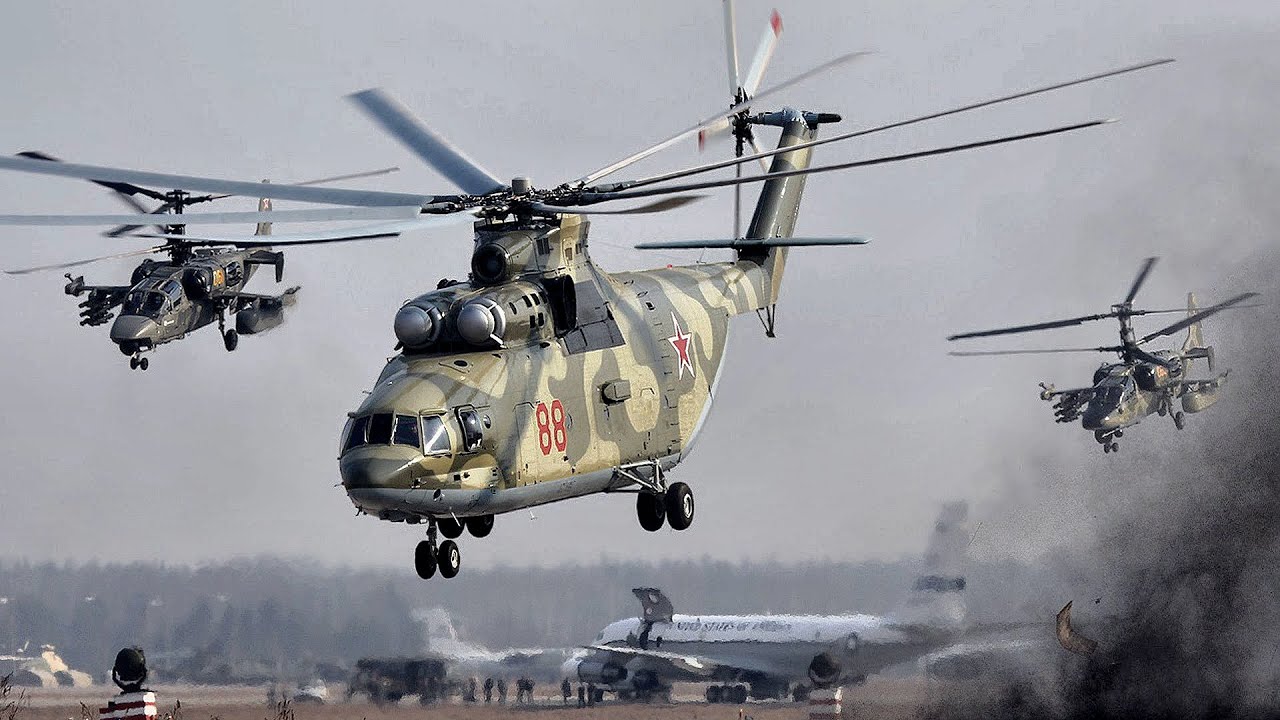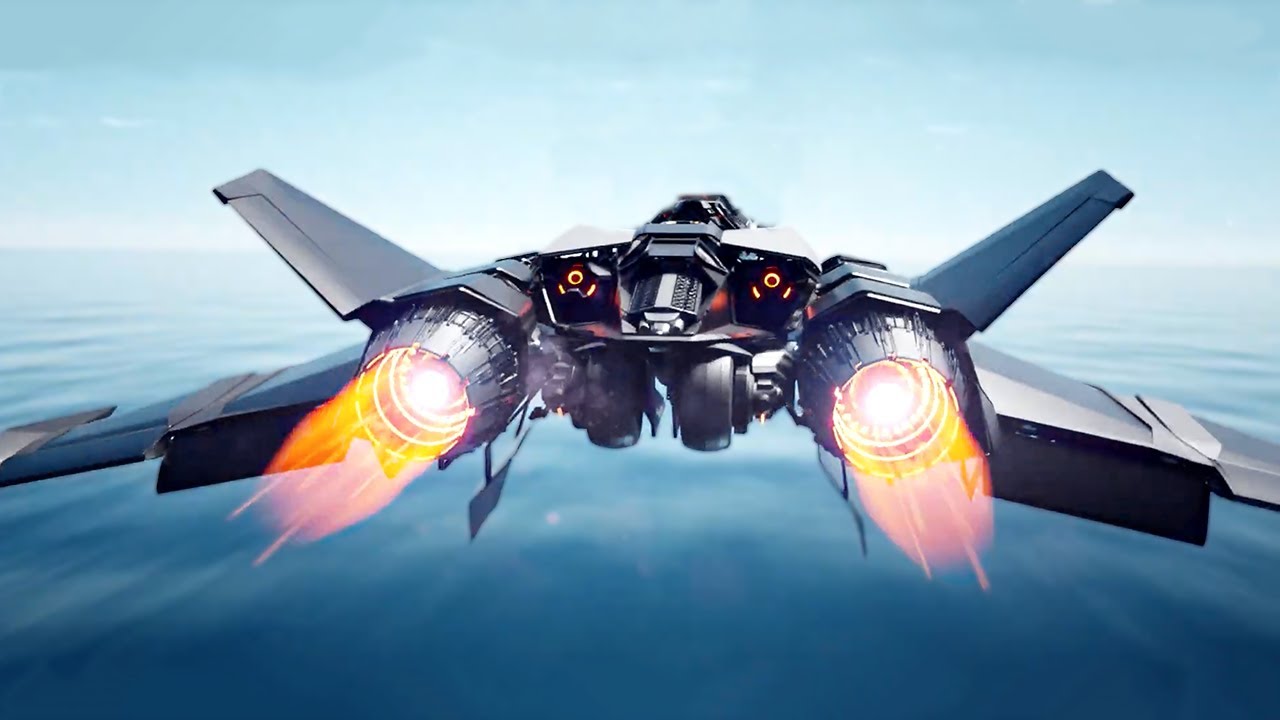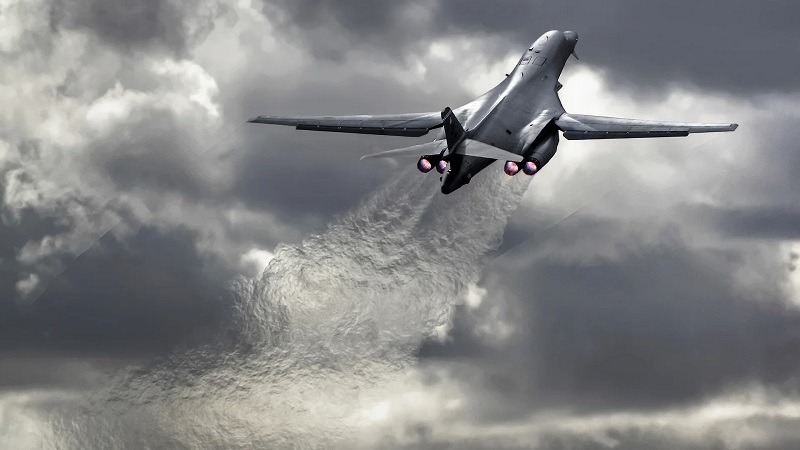Helicopters Military
The Mil Mi-26 Halo is the world’s largest production helicopter

The Mi-26 (NATO designation Halo) is a twin-turbine heavy-lift helicopter. It is the world’s largest production helicopter. The Halo’s development started in the early 1970s. The designer’s goal was to produce a helicopter with a load capacity twice that of any contemporary helicopter. The first Mi-26 Halo prototype flew in December 1977 and was first displayed at the Paris Air Show in 1981. In 1982, Russian squadrons received their first Halos, which were not fully operational until 1983. In 1986, India was the first country to purchase a Halo. Since then Halos have been sold to nearly twenty countries. The cost of a Halo is between $10 million and $12 million.

The Halo has the load-carrying capability of a domestic C-130 transport plane. Its cargo area, with the rear ramp closed, is 12 m long, and 3.2 m wide, with a minimum ceiling height of 2.9 m. This cargo area can hold two combat vehicles weighting 9 988 kg each. The interior can be configured to seat 80 combat-equipped troops or 60 stretchers. However there were cases when this helicopter was flying overloaded with 150 troops. The Halo is flown by a crew of four: pilot, copilot, flight engineer, and navigator. The flight deck and cabin are fully air conditioned, but only the flight deck is pressurized.

The Halo’s landing gear is a noretractable tricycle-type with a steerable nose wheel. The main gear can be hydraulically adjusted to facilitate loading through the rear door. This adjustable feature is also used when landing on varied surfaces. Each of the main gears has a sensor to determine takeoff weight. This information is displayed at the flight engineer’s station at liftoff.

The Halo’s retractable tail skid offers unrestricted accessibility to the rear cargo loading door. There is a hatch on the underside of the fuselage that opens to give access to a load sling. This sling is attached to an internal winch that’s in-line with the main rotor shaft. Closed-circuit television cameras enable crew members to monitor the load beneath the aircraft.

The Halo was the first helicopter to successfully fly with an eight-blade main rotor. This rotor is 32 m in diameter and is made of composites and aluminum alloys, with a leading edge made of titanium. The main rotor head and the tail rotor head are both made of titanium. The flight controls are hydraulically boosted with a redundant autopilot and stability-augmentation system. The enormous Halo is powered by two 10 000-shaft-horsepower ZMKB Progress D-136 turboshaft engines. Each engine bay is made of titanium for protection against fire. Several variants of the Mi-26 Halo have been built.

Helicopters Military
5 Fastest Fighter Jets in the World Ever And Still Active Today

It is undeniable, that ancient or ancient fighter jets have become technology that has been reaping admiration to this day. For example, the F-15 Eagle and MiG-29 were rivals in their time. This of course cannot be separated from how today’s fighter jets are made.
By paying attention to the details and existing technology, a more modern fighter jet was formed. However, unfortunately not all modern fighter jets can satisfy today’s engineers and experts. In fact, in terms of speed, it is known that most of the ancient fighter jets dominated.
So, which are the fastest fighter jets in the world? According to the Bulgarian Military, here is a list of active and fastest fighter jets in the world!
Grumman F-14 Tomcat (2,485 km/h), USA

It is undeniable that the Tomcat is an older generation. In fact, the film Top Gun: Maverick illustrates how this jet lacks the features of today’s era. In this case, in fact the Tomcat is still used by Iran.
Grumman Aircraft Engineering Corporation is the manufacturer of that aircraft. Despite its age, it is known that it is a reliable interceptor that can accompany four targets at once while simultaneously capturing up to 6 targets.
Eurofighter Typhoon (2,495 km/h), Germany

Germany put its Armed Forces “Typhoon” representative into production in 2003. Most of the hull is made of a special coating that blocks electromagnetic waves, while the combat radius of the fighter aircraft is 1,390 km. This fighter jet is also owned by Britain and Italy. There are about 500 such fighters in the world.
Su-35 fighter jet (2,500 km/h), Russia

This aircraft is the most formidable fighter of the Russian Air Force, currently in service. This powerful fighter with two modern engines is a modern Su-27 fighter produced in Soviet times.
The Su-35 can climb to a height of 20,000 meters, perform aerobatics, and carry a sizeable payload. All these tactical and technical characteristics, coupled with advanced electronic equipment and weᴀponѕ, turn the Su-35 fighter into a dangerous foe for any foreign fighter.
Su-57 fighter jet (2,600 km/h), Russia

This aircraft is a Russian 4++ generation fighter. This fighter is characterized by the extensive use of stealth and artificial intelligence technologies. The electronics would take over most of the test work, freeing up pilots to carry out combat missions. The maximum speed of the Su-57 is nearly 200 km/h more than the American F-22 Raptor.
McDonnell Douglas F-15 Eagle (2 650 km/h), USA

This aircraft is the perfect leader in its class and is distinguished by excellent speed and maneuverability. The tactical all-weather fighter appeared in 1976, with production scheduled for 2025 to arm America. A total of 1,500 of these items are known to exist and all fighters are in the United States.
That’s the world’s fastest active fighter jet. Now, the fighter jet is still adorning the defense technology industry in various countries.
Helicopters Military
B-1 Lancer: This Bomber Is The Ultimate Survivor

The B-1 Lancer, nicknamed the “Bone,” is the United States’s only supersonic bomber. The B-1 compliments the other US bombers – the workhorse B-52 Stratofortress and the stealthy B-2 Spirit. Unlike the B-52 and B-2, however, the B-1 is capable of breaking the sound barrier. That the B-1 can hit Mach 1.2 is especially impressive given that the bomber also can carry a 25-ton payload.

Despite the B-1’s impressive capabilities, the bomber was canceled before entering service, and actually had to be saved from the scrapheap.
B-1: A History
During the Eisenhower administration, the US Air Force began looking for a new bomber – something that could combine the raw speed of the Convair B-58 Hustler with the hefting ability of the B-52. Initially, the North American B-70 Valkyrie – a bomber featuring six engines, which could reach Mach 3 and a 70,000-foot service ceiling – was selected.
Yet, improvements in the Soviet air defense systems, specifically their surface-to-air missiles, rendered the Valkyrie’s high-altitude flight more dangerous – which forced the Valkyrie to conduct bomb runs at lower altitude. That was a problem, however; at low altitudes, the Valkyrie suffered from higher aerodynamic drag – which limited the bomber to subsonic speeds and a short range. In effect, the Valkyrie was redundant – less useful even – than the already serving B-52. Accordingly, the Valkyrie program was canceled.

Multiple programs were formed to develop a bomber capable of supplementing the B-52 – which was poorly matched for low-level bombing runs. The programs, which hoped to find a long-term fix, included the Subsonic Low-Altitude Bomber (SLAB), Advanced Manned Precision Strike System (AMPSS), and the Advanced Manned Strategic Aircraft (AMSA) – neither developed much in terms of a tangible product, and were eventually limited when Secretary of Defense Robert McNamara steered the DoD away from bombers development and towards ICBM development.
President Richard Nixon brought AMSA back from the dead in 1969, however. North American Rockwell won the AMSA contract – edging out Boeing and General Dynamics – and began to develop the prototype which would become the B-1.
Development of the B-1 went smoothly enough through the 1970s – but then something unexpected happened. A Soviet pilot defected, bringing with him a heap of intelligence.
In 1976, Viktor Belenko landed his MiG-25 Foxbat in Japan. Belenko was an extremely valuable source of intelligence; among the tidbits he shared: the Soviets were developing a “super-Foxbat” (most likely the MiG-31) with an advanced radar system that would allow for the easy detection of low-flying aircraft (like the B-1). Belenko’s intelligence suggested that the B-1 would be functionally useless the minute it entered service.

Jimmy Carter, who was then campaigning for president, made responsible defense spending a cornerstone of his policy proposals.
Carter bashed the B-1 program in particular throughout his campaign – and when he was elected president, he ordered a study that resulted in the cancellation of the B-1 program.
THE LANCER MAKES A COMEBACK
It was not until President Ronald Reagan won the 1980 election, replacing Carter, that the B-1 program was renewed. Reagan had campaigned on the premise that Carter was a weak leader, weak on defense; Reagan cited the B-1 cancellation as a primary example of Carter’s weakness on defense-related issues.

So, predictably, when Reagan took office, he reinitiated the B-1 program, and in January 1982, the USAF ordered 100 B-1 bombers from Rockwell.
Politics almost prevented the B-1 from entering service – but the supersonic bomber got there, albeit in a roundabout way. The B-1 is still in service today but plans are in place to have the B-1 phased out by 2036.
Helicopters Military
AH-1W Super Cobra Is The First Attack Helicopter In The World – Honestly “Terrible”
Service: USMC Armament: 20 mm M197 Gatling cannon; Hydra 70 rockets; 5 in Zuni rockets; TOW missiles; AGM-114 Hellfire; AIM-9 Sidewinder. Speed: 170 knots Range: 58 nm Propulsion: 2x GE T700-GE-401 turboshaft engines Crew: 2

Originating from a concept demonstrator delivered to the U.S. Army in 1962 based upon a UH-1 Huey, the AH-1W Super Cobra is the world’s first attack helicopter. Marines have been flying the AH-1W Super Cobra since 1986. The last AH-1W was delivered in 1998.
The AH-1W is being replaced by the AH-1Z, starting in 2006 as part of a remanufacture program. The Last AH-1W is expected to be replaced in 2020. AH-1Ws are fielded in Marine Light Attack Helicopter Squadrons, or HMLAs, along with the UH-1N.
Super Cobra helicopters form the backbone of the Marine Corps’ air-ground task force and act as on-call close air support platforms for Marines under fire. Cobras are also used for ground attack coordination, with pilots trained to call in artillery or mortars on positions while orbiting above the battlefield.
The Super Cobra was the first attack helicopter to qualify both the Sidewinder air-to-air missile and the Sidearm anti-radiation missile. Both missiles can use the same LAU-7 rail launcher. Sidearm has a range of more than 15km. AIM-9L Sidewinder is an all-aspect, short-range, air-to-air missile produced by Lockheed Martin and Raytheon. The missile has a range of 15km.







